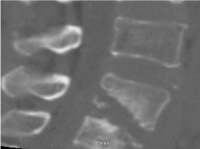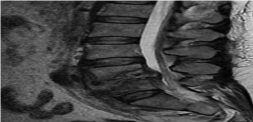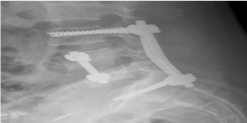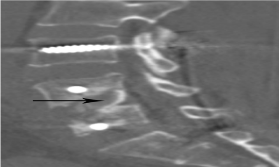Case Report
Anterior Debridement and Fusion Followed by 360° Fixation in Pyogenic Spontaneous Spondylodiscitis of L4- L5: Autologous Iliac Bone Strut, Anterior Titanium Screw- Rod Fixation and Posterior Pedicle Screw Fixation: A Case Report
Zhang H* and Wu Q
Department of Orthopaedic Surgery, Zhejiang University, China
*Corresponding author: Hua Zhang, Department of Orthopaedic Surgery, 2nd Affiliated Hospital, School of Medicine, Zhejiang University, No.88 Jiefang Road, Hangzhou, China
Published: 11 May, 2016
Cite this article as: Zhang H, Wu Q. Anterior Debridement
and Fusion Followed by 360° Fixation in
Pyogenic Spontaneous Spondylodiscitis
of L4-L5: Autologous Iliac Bone Strut,
Anterior Titanium Screw-Rod Fixation
and Posterior Pedicle Screw Fixation: A
Case Report. Clin Surg. 2016; 1: 1003.
Abstract
Objective: To describe a new kind of 360° fixation in pyogenic spontaneous spondylodiscitis of L4-
L5 after anterior debridement and fusion.
Summary of Background Data: The adequate surgical treatment modalities for pyogenic
spontaneous spondylodiscitis has not been unequivocally defined until present, especially in the use
of metal instruments at such a septic focus.
Methods: The 54-year patient, who was in an active period of pyogenic spondylitis, treated with
surgical intervention involved aggressive anterior debridement and removal of the infected vertebral
body of L4 -L5, followed by reconstruction of the anterior column using autologous iliac bone strut
and anterior titanium screw-rod fixation (in L4 and L5 residual vertebral body), and posterior
pedicle screw fixation in L3 and S1. The patient was given antibiotic treatment with cefotiam,
initially with intravenous administration, which was switched to oral administration after 21 days.
Results: No further relapse of spondylodiscitis have been detected during routine clinical and
radiographic check-ups, with ongoing follow-up. The inflammatory parameters have been in the
normal range. The patient is well mobilized, using walking feet for long distances, and she has no
obvious pain. The radiographs showed the disappearance of extramedullary abscess, no changes
in the implant such as loosening of the screws or fracture, iliac bone graft absorption collapse, and
partial fusion between vertebral body and bone graft.
Conclusion: This new 360° fixation may be a good surgical treatment alternative, especially in an
active period of pyogenic spondylitis, with significant and irregular bone defects.
Keywords: Pyogenic spontaneous spondylodiscitis; Lumbar; Debridement; Fixation
Introduction
There is general agreement that an anterior debridement and fusion is preferable for pyogenic spontaneous spondylodiscitis, due to direct access to the infected tissues, and the use of metal implants in pyogenic spondylodiscitis has traditionally been rigorously avoided since the implants increase bacterial adherence and decrease antibiotic effectiveness [1-4]. More recently, this notion has been challenged by reports in the literature which presented favorable outcomes using titanium implants in the aggressive debridement and spinal stabilization procedures of spondylodiscitis, includes titanium cages, pedicle screw, and so on [5-9]. However, the adequate surgical treatment modalities for the infected spine have not been unequivocally defined until present, especially in the use of anterior metal implants at such a septic focus. In the present paper, we present the good outcome example of a 59-year old patient with anterior debridement and fusion followed by a new kind of 360° fixation: autologous iliac bone strut, anterior titanium screw-rod fixation(instead of titanium mesh cage), and posterior pedicle screw fixation.
Case Report
On January 10, 2015, a 54-year-old woman was transferred to our department with massive
lumbar pain, neurological dysfunction, and had raised CRP (107.5
mg/dL) and ESR (121 mm/h). Her medical history showed that she
had been presented to another hospital with severe lumbar pain and
high fever and undergone conservative treatment by intravenous
antibiotics (cefotiam 2.0g i.v. bid) for just 2 weeks at September 2010.
However, she continued to have raised inflammatory parameters(Creactive
protein [CRP] 76.0 mg/dL) and severe lumbar pain. In
December 2010, she developed progressive spastic paraparesis,
radicular numbness of her right lower extremities. Magnetic resonance
imaging (MRI) and Computed tomographs (CT) of the spine was
carried out, leading to the diagnosis of L4–L5 spondylodiscitis
with significant bone destruction, anterior paravertebral abscess
and spinal canal compression (Figure 1). Intravenous antibiotic
treatment with Cefotiam in accordance with the resistogram was not
successful (with persistently lumbar pain, progressive neurological
dysfunction, and high CRP values around 45.6 –122.5 mg/dL). On
January 25, 2015, the surgical intervention involved aggressive
anterior debridement and removal of the infected vertebral body
of L4-L5, followed by reconstruction of the anterior column using
autologous iliac bone strut and anterior titanium screw-rod fixation
(in L4 and L5 residual vertebral body), and posterior pedicle screw
fixation in L3 and S1. (Figure 2). The diagnosed methicillin-sensitive
S. aureus was identified in intraoperative biopsies from the spine.
The patient was therefore given antibiotic treatment with cefotiam,
initially with intravenous administration, which was switched to oral
administration after 21 days. CRP values continued to decline to
6mg/dL on February 8, 2015.
Since then, no further relapse of spondylodiscitis has been
detected during routine clinical and radiographic check-ups, with
ongoing follow-up. Three months later, with a clinical examination,
blood testing showed normal CRP (1.2 mg/dL) and no elevation
of leukocytes. Three months later, MRI and CT (Figure 3) showed
the disappearance of extramedullary abscess, partial fusion between
vertebral body and bone graft, and suggested no evidence of iliac
bone graft absorption collapse, loosening of the screws or fracture.
Figure 1A
Figure 1B
Figure 2A
Figure 2B
Figure 3A
Figure 3A
Computed tomographs 3 months later, partial fusion between
vertebral body and bone graft (arrow).
Figure 3B
Figure 3B
Computed tomographs 3 months later, partial fusion between
vertebral body and bone graft (arrow).
Discussion
Extensive debridement of the anterior column of the spine, which
is known to be predominantly involved in vertebral osteomyelitis,
often leads to spinal instability. Structural bone autografts represent
the "gold standard" for reconstruction of these anterior column
defects, but recent studies have supported the use of titanium mesh
cages to bypass the morbidity associated with structural autografts
and may provide better anterior column support(maintain their
structural integrity in an infected environment) [5-8]. A study
reported the subsidence rate was higher in the strut group than in the
cage group (two groups followed by posterior pedicle screw fixation),
and the duration until subsidence was also shorter in the strut
group than in the cage group [10]. However, there is a high risk of
relapse that metal implants are implanted in sites of active infections,
because it may decrease antibiotic effectiveness and increase bacterial
adherence and glycocalyx formation [2-4]. Tobias et al reported a
case of two recurrences after surgical intervention with debridement,
and reconstruction of the anterior column with titanium mesh cage
[11]. There is currently a lack of consensus in the pertinent literature
regarding the appropriate fixation modalities. Various authors
advocated combined with additional posterior spinal fixation, and
excellent imaging results can be obtained without impairing infection
eradication [6,12,13].
In the present case, the 54-year patient was in an active period
of pyogenic spondylitis, there would be a high risk of relapse, if
titanium mesh cage was implanted in the defect area. Additionally,
more vertebral body including no infect bone had to be removed
to adapt to the shape of cage. Once relapse of pyogenic spondylitis
appeared, extensive debridement should to be done again, and
removal the mesh cage means surgical failure. In this case, autologous
bone grafts and screw - rod fixation system were used to instead of
titanium mesh cage with bone graft. Compared with the cage fixation,
this surgical treatment could retain no infected vertebral body as
much as possible and provided more bone graft- vertebrae contact
area. Furthermore, in case of the infection relapse, reoperation of
anterior debridement and removal of the anterior screw - rod fixation
is a positive alternative, and the 360° fixation of iliac bone graft and
posterior pedicle screw fixation can still provided enough stability.
Follow-up results suggested that anterior bone graft has been partial
fusion. Therefore, this 360° fixation may be a good surgical treatment
alternative, especially in an active period of pyogenic spondylitis, with
significant and irregular bone defects.
References
- Ha KY, Chung YG, Ryoo SJ. Adherence and biofilm formation of Staphylococcus epidermidis and Mycobacterium tuberculosis on various spinal implants. Spine (Phila Pa 1976). 2005; 30: 38-43.
- Barth E, Myrvik QM, Wagner W, Gristina AG. In vitro and in vivo comparative colonization of Staphylococcus aureus and Staphylococcus epidermidis on orthopaedic implant materials. Biomaterials. 1989; 10: 325-328.
- Gristina AG, Hobgood CD, Webb LX, Myrvik QN. Adhesive colonization of biomaterials and antibiotic resistance. Biomaterials. 1987; 8: 423-426.
- Oga M, Sugioka Y, Hobgood CD, Gristina AG, Myrvik QN. Surgical biomaterials and differential colonization by Staphylococcus epidermidis. Biomaterials. 1988; 9: 285-289.
- Fayazi AH, Ludwig SC, Dabbah M, Bryan Butler R, Gelb DE. Preliminary results of staged anterior debridement and reconstruction using titanium mesh cages in the treatment of thoracolumbar vertebral osteomyelitis. Spine J. 2004; 4: 388-395.
- Hee HT, Majd ME, Holt RT, Pienkowski D. Better treatment of vertebral osteomyelitis using posterior stabilization and titanium mesh cages. J Spinal Disord Tech. 2002; 15: 149-156.
- Korovessis P, Petsinis G, Koureas G, Iliopoulos P, Zacharatos S. Anterior surgery with insertion of titanium mesh cage and posterior instrumented fusion performed sequentially on the same day under one anesthesia for septic spondylitis of thoracolumbar spine: is the use of titanium mesh cages safe? Spine (Phila Pa 1976) 2006; 31: 1014-1019.
- Kuklo TR, Potter BK, Bell RS, Moquin RR, Rosner MK. Single-stage treatment of pyogenic spinal infection with titanium mesh cages. J Spinal Disord Tech. 2006; 19: 376-382.
- Ruf M, Stoltze D, Merk HR, Ames M, Harms J. Treatment of vertebral osteomyelitis by radical debridement and stabilization using titanium mesh cages. Spine (Phila Pa 1976). 2007; 32: E275-280.
- Pee YH, Park JD, Choi YG, Lee SH. Anterior debridement and fusion followed by posterior pedicle screw fixation in pyogenic spondylodiscitis: autologous iliac bone strut versus cage. J Neurosurg Spine. 2008; 8: 405- 412.
- Lange T, Schulte TL, Bullmann V. Two recurrences of adjacent spondylodiscitis after initial surgical intervention with posterior stabilization, debridement, and reconstruction of the anterior column in a patient with spondylodiscitis: a case report. Spine (Phila Pa 1976). 35: E804-810.
- Dimar JR, Carreon LY, Glassman SD, Campbell MJ, Hartman MJ, Johnson JR. Treatment of pyogenic vertebral osteomyelitis with anterior debridement and fusion followed by delayed posterior spinal fusion. Spine (Phila Pa 1976). 2004; 29: 326-332.
- Ha KY, Shin JH, Kim KW, Na KH. The fate of anterior autogenous bone graft after anterior radical surgery with or without posterior instrumentation in the treatment of pyogenic lumbar spondylodiscitis. Spine (Phila Pa 1976). 2007; 32: 1856-1864.






